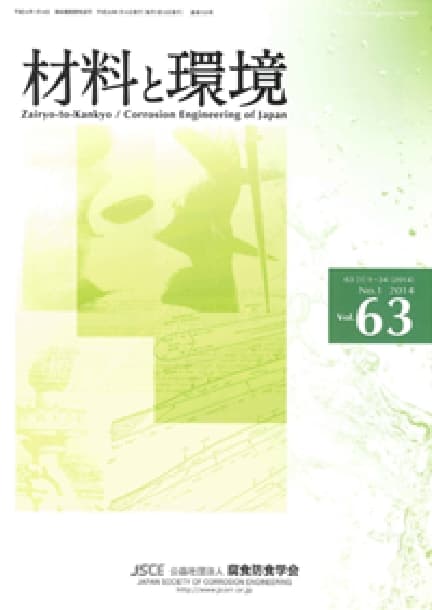- TOP
- Zairyo-to-Kankyo
- Vol. 71 (2022), No. 2
Zairyo-to-Kankyo Vol. 71 (2022), No. 2
Backnumber
-
Vol. 74 (2025)
-
Vol. 73 (2024)
-
Vol. 72 (2023)
-
Vol. 71 (2022)
-
Vol. 70 (2021)
-
Vol. 69 (2020)
-
Vol. 68 (2019)
-
Vol. 67 (2018)
-
Vol. 66 (2017)
-
Vol. 65 (2016)
-
Vol. 64 (2015)
-
Vol. 63 (2014)
-
Vol. 62 (2013)
-
Vol. 61 (2012)
-
Vol. 60 (2011)
-
Vol. 59 (2010)
-
Vol. 58 (2009)
-
Vol. 57 (2008)
-
Vol. 56 (2007)
-
Vol. 55 (2006)
-
Vol. 54 (2005)
-
Vol. 53 (2004)
-
Vol. 52 (2003)
-
Vol. 51 (2002)
-
Vol. 50 (2001)
-
Vol. 49 (2000)
-
Vol. 48 (1999)
-
Vol. 47 (1998)
-
Vol. 46 (1997)
-
Vol. 45 (1996)
-
Vol. 44 (1995)
-
Vol. 43 (1994)
-
Vol. 42 (1993)
-
Vol. 41 (1992)
-
Vol. 40 (1991)
Keyword Ranking
13 Dec. (Last 30 Days)
Zairyo-to-Kankyo Vol. 71 (2022), No. 2
Effect of Oxygen Concentration on Corrosion Rate of Carbon Steel in Air/solution Alternating Condition
Kyohei Otani, Fumiyoshi Ueno, Chiaki Kato
pp. 40-45
DOI:
10.3323/jcorr.71.40Abstract
The purpose of this study is to investigate the effect of oxygen concentration in the air on the corrosion rate of carbon steel in an air/solution alternating environment in the low oxygen concentration range and to clarify the corrosion rate and corrosion mechanism of carbon steel depending on the oxygen concentration in air by the mass change of specimens before and after the corrosion test and observing the iron rust layer formed on the surface of carbon steel. The corrosion rate increases with increasing oxygen concentration in the air, and the gradient of the corrosion rate decreases gradually. The maximum erosion depth increased with increasing oxygen concentration except for the case of 1% oxygen concentration, however, the maximum erosion depth for 1% oxygen concentration was larger than that for 5% air oxygen concentration. It was clarified from the cross-sectional observation that the reason for the specific increase in the maximum erosion depth only when the oxygen concentration was 1% due to the localized corrosion of carbon steel.
Statistical Analysis of Nonmetallic Inclusions as Initiation Sites of Pitting Corrosion for Stainless Steel by All-surface Survey
Kenichiro Eguchi
pp. 46-56
DOI:
10.3323/jcorr.71.46Abstract
All nonmetallic inclusions on the surface of a stainless steel sample were analyzed with a scanning electron microscope with a function of automatically observing and analyzing nonmetallic inclusions. The effect of the inclusion type and size on the tendency of pit initiation was then quantitatively evaluated by observing the pits generated on the sample surface. It was found that the probability of stable pit growth increased as the major axis of the inclusions increased, but no effect of the inclusion type was observed. However, an effect of the inclusion type on the tendency of repassivation pit initiation was observed.
Article Access Ranking
13 Dec. (Last 30 Days)
-
Delayed Fracture Mechanism of 1700 MPa-Class Quenched and Tempered Bolt under Atmospheric Corrosion Environment
Tetsu-to-Hagané Advance Publication
-
Perspectives on the Promising Pathways to Zero Carbon Emissions in the Steel Industry toward 2050
ISIJ International Vol.65(2025), No.2
-
Effect of B on Surface Oxidation Behavior and Phosphatability of Si-Mn-added Cold-Rolled Steel Sheets
ISIJ International Advance Publication
-
Factors Influencing the Bonding Phase Structure of Iron Ore Sinters
ISIJ International Vol.43(2003), No.9
-
Effect of microstructural heterogeneity on fatigue limit of as-quenched low-carbon low-alloy martensitic steel
ISIJ International Advance Publication
-
Prussian blue as a fully reversible hydrogenochromic material for visualizing hydrogen distribution in Fe sheet
ISIJ International Advance Publication
-
Progress of Strip Casting Technology for Steel; Historical Developments
ISIJ International Vol.52(2012), No.12
-
Research Progress on Optimal Blending of Iron Ore Powders for Sintering
ISIJ International Vol.65(2025), No.12
-
-
Microstructures and Reduction Properties of High CaO Concentration Sintered Ore
ISIJ International Advance Publication
You can use this feature after you logged into the site.
Please click the button below.










